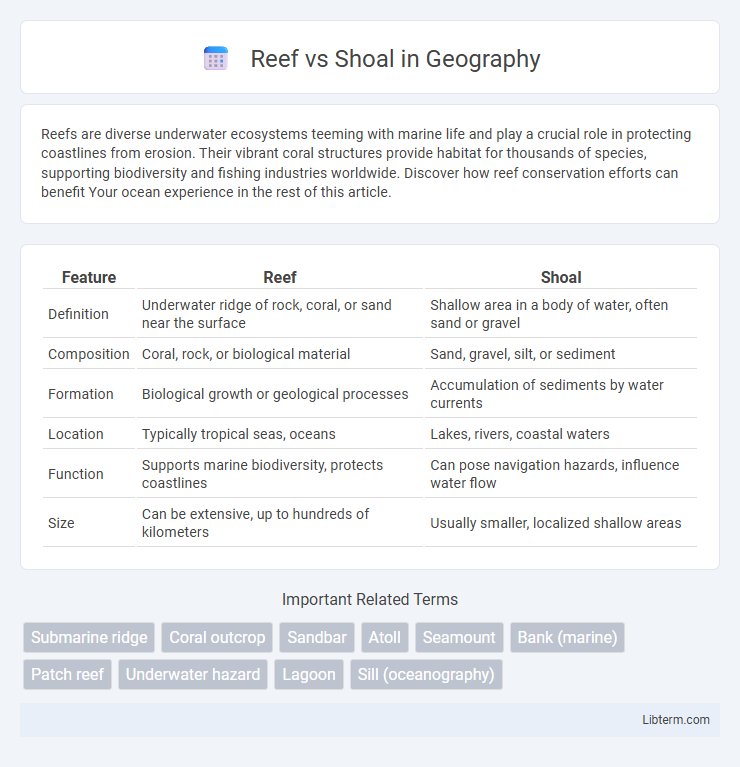Reefs are diverse underwater ecosystems teeming with marine life and play a crucial role in protecting coastlines from erosion. Their vibrant coral structures provide habitat for thousands of species, supporting biodiversity and fishing industries worldwide. Discover how reef conservation efforts can benefit Your ocean experience in the rest of this article.
Table of Comparison
| Feature | Reef | Shoal |
|---|---|---|
| Definition | Underwater ridge of rock, coral, or sand near the surface | Shallow area in a body of water, often sand or gravel |
| Composition | Coral, rock, or biological material | Sand, gravel, silt, or sediment |
| Formation | Biological growth or geological processes | Accumulation of sediments by water currents |
| Location | Typically tropical seas, oceans | Lakes, rivers, coastal waters |
| Function | Supports marine biodiversity, protects coastlines | Can pose navigation hazards, influence water flow |
| Size | Can be extensive, up to hundreds of kilometers | Usually smaller, localized shallow areas |
Understanding Reefs and Shoals
Reefs are underwater structures composed primarily of coral, rock, or other marine organisms that provide complex habitats supporting diverse ecosystems. Shoals consist of naturally occurring sandbars or sediment accumulations formed by tidal and current actions, often posing navigation hazards. Understanding reefs involves recognizing their ecological significance and biodiversity, while understanding shoals focuses on their geological formation and impact on coastal environments.
Key Differences Between Reefs and Shoals
Reefs are submerged or partially exposed rocky structures formed primarily by coral or other marine organisms, providing critical habitats for diverse marine life and often extending over large areas. Shoals are shallow sandbanks or gravel bars that rise close to the water surface, usually formed by sediment accumulation and characterized by their dynamic, shifting nature. The key difference lies in composition and biological activity: reefs are biologically constructed ecosystems supporting complex biodiversity, whereas shoals are physical sediment deposits affecting navigation and coastal processes.
Formation Processes: Reefs vs Shoals
Reefs primarily form through the accumulation of calcium carbonate from coral skeletons and calcareous algae, creating complex structures over thousands of years in warm, shallow marine waters. Shoals develop from the deposition of sand, silt, and gravel by currents, waves, or tides, resulting in shallow areas that can shift over time. While reefs are biologically constructed, shoals are sediment-based features shaped by hydrodynamic forces.
Geological Composition of Reefs and Shoals
Reefs primarily consist of calcareous structures formed from the skeletal remains of marine organisms such as corals, algae, and shellfish, contributing to their solid, biologically-driven composition. Shoals are typically composed of unconsolidated sediments like sand, silt, and gravel deposited by currents and waves, resulting in loose, sedimentary formations. Geological composition of reefs involves biogenic carbonates, while shoals consist predominantly of clastic materials.
Marine Life in Reefs vs Shoals
Reefs, particularly coral reefs, support diverse marine ecosystems with complex habitats that house thousands of species including fish, crustaceans, and mollusks. Shoals, composed primarily of sand or gravel, provide important breeding and feeding grounds for certain fish and bird species but lack the structural complexity that supports large biodiversity. The rich biodiversity of reefs contributes to their role as crucial nurseries and refuge zones for marine life, unlike the relatively simpler ecosystems found in shoals.
Navigation Hazards: Reefs Compared to Shoals
Reefs pose significant navigation hazards due to their rigid, rocky structures often lying just below the water surface, increasing the risk of vessel grounding or hull damage. Shoals, composed primarily of loose sand or sediments, tend to shift over time, creating unpredictable shallow areas that can trap ships or reduce navigable water depth. Both features require precise charting and vigilant navigation to prevent maritime accidents, but reefs generally present a more constant and severe threat compared to the transient nature of shoals.
Ecological Importance of Reefs and Shoals
Reefs, primarily composed of coral or rock, provide critical habitats supporting high biodiversity by offering shelter, breeding grounds, and feeding areas for numerous marine species, thereby maintaining ecological balance. Shoals, typically composed of sand or sediment, play a vital role in coastal protection by dissipating wave energy and preventing erosion while serving as nurseries for fish and invertebrates. Both ecosystems contribute significantly to nutrient cycling, carbon sequestration, and support fisheries, underscoring their essential function in sustaining marine life and coastal resilience.
Human Impact on Reefs and Shoals
Human activities significantly impact reefs and shoals through pollution, overfishing, and coastal development, leading to habitat degradation and loss of biodiversity. Reefs, particularly coral reefs, are vulnerable to ocean acidification and temperature rise caused by climate change, resulting in coral bleaching and weakened structural integrity. Shoals face sedimentation changes and water quality decline from land runoff, reducing their capacity to support marine life and affecting local fisheries.
Notable Examples of Reefs and Shoals Worldwide
The Great Barrier Reef in Australia is the world's largest coral reef system, famous for its biodiversity and extensive underwater ecosystems, while the Belize Barrier Reef is renowned as the second largest and a UNESCO World Heritage Site. The Florida Keys reef tract represents a significant example of shoal formations, characterized by shallow sandbanks and coral heads that provide essential habitats for marine life and navigational challenges. Other notable shoals include the Nantucket Shoals off Massachusetts, known for their treacherous waters, and the Dogger Bank in the North Sea, a vital fishing ground formed by a large sandbank.
Reef or Shoal: Which is More Vulnerable?
Shoals, characterized by shallow sandbanks or gravel bars, are generally more vulnerable to environmental changes due to their loose sediment structure and exposure to wave action. Reefs, primarily composed of coral or rock, offer more stability but face significant threats from ocean acidification, bleaching, and human activities like dredging. While reefs are biologically richer and critical for marine biodiversity, shoals' physical fragility makes them more immediately susceptible to erosion and habitat loss.
Reef Infographic

 libterm.com
libterm.com